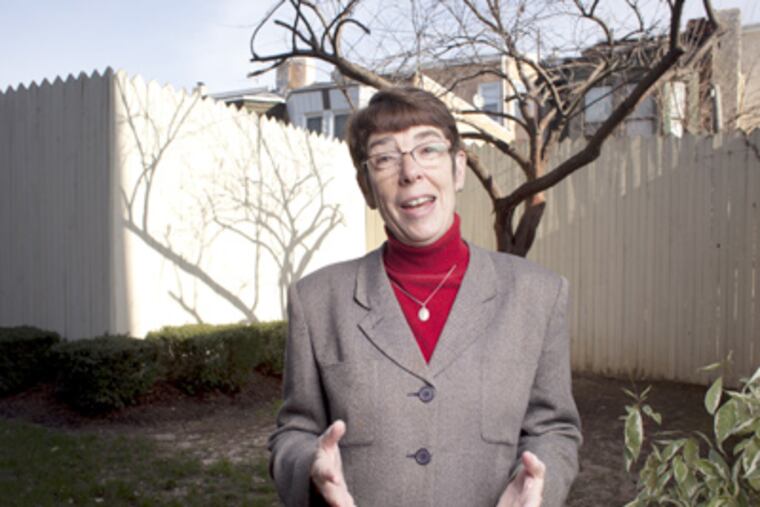Inquirer Editorial: Reminding us of the forgotten
The Occupy movement arrived in Philadelphia in October, taking over Dilworth Plaza for nearly eight weeks and airing grievances about unemployment, homelessness, and more. But as with other Occupiers around the country, their message was muddied: It never became clear what the protesters wanted or how they would get it.

The Occupy movement arrived in Philadelphia in October, taking over Dilworth Plaza for nearly eight weeks and airing grievances about unemployment, homelessness, and more. But as with other Occupiers around the country, their message was muddied: It never became clear what the protesters wanted or how they would get it.
The movement could learn much from SISTER MARY SCULLION, the tireless and effective advocate for the homeless whom the Editorial Board has named The Inquirer's 2011 Citizen of the Year. For more than two decades, Sister Mary, 58, has been in the forefront of an uphill battle to improve the lot of the destitute men, women, and children who wander and sleep on the streets. And she has achieved tangible results.
Philadelphia has about 500 homeless people living on its streets. About 3,000 more, including 1,000 children, live in city shelters.
"We can and we have to do better," Sister Mary said in a recent interview. Homelessness, she said, "affects so many more families and people than most of us could imagine."
This year, Sister Mary led the opposition to City Council's proposed crackdown on aggressive panhandlers. She helped negotiate a sensible compromise that gave police the authority to safeguard the public without criminalizing homelessness.
Also among the fruits of her labor this year is Connelly House, which offers refuge for the formerly homeless in 79 affordable rental units in Center City. Another group of units, for homeless veterans, is set to open this year.
Sister Mary also recently landed a $2 million grant from a Widener heir's fortune to support the nonprofit she helped found and continues to direct, Project HOME. Much of the money has been spent on renovations of 53 apartments in North Philadelphia. Formerly homeless tenants have already started moving in.
A humble woman of God who considers service a privilege, Sister Mary credits a team effort with bettering the lives of the city's homeless. But she stands out as an unwavering champion of the downtrodden and otherwise forgotten.
Sister Mary began working at a Center City women's shelter run by her order, the Sisters of Mercy, in 1978, providing food, blankets, and lodging to those on the streets. The work would help define her calling.
Project HOME's motto is "None of us are home until all of us are home," and Sister Mary has fought City Hall, staged demonstrations, and even been arrested in pursuit of that principle. She has gotten the attention of the White House and rocker Jon Bon Jovi, a generous benefactor who included her in a video as one of his heroes. In 2009, Time magazine put her on its list of the world's 100 most influential people, alongside the likes of President Obama and Oprah Winfrey.
"It's hard to find anyone in our region who has had more of an impact," said David L. Cohen, a Comcast executive who has worked closely with Sister Mary on philanthropic projects. "She could be citizen of the decade or even longer."
Sister Mary acknowledges that much remains to be done. The sluggish economy has left more homeless, though not as many as some feared. She applauds Mayor Nutter's efforts to find permanent housing for more of the city's homeless. And she says jobs, health care, and public education are part of the solution, too.
"We're all standing on our sisters' and brothers' shoulders," she said. "It is our responsibility to create meaningful opportunities for those left behind."
Sister Mary was among two dozen worthy nominations Inquirer readers submitted for Citizen of the Year. They included Shelly Yanoff, executive director of Public Citizens for Children and Youth; Jane Golden, executive director of the city's Mural Arts Program; and Joe Natale, who has sent about 1,300 care packages to troops.
This is The Inquirer's eighth Citizen of the Year Award seeking to honor those who uphold the ideals of citizenship, promoting justice, strengthening democracy, and fostering community. The Editorial Board considers nominees from business, science and medicine, education, government, arts and culture, civic activism, sports, and entertainment.
In 2010, the award went to Helene Pierson of the Heart of Camden for her work to improve the South Camden waterfront. In 2009, the winners were attorneys Marsha Levick and Lourdes Rosado of the Juvenile Law Center, who exposed juvenile-court abuses in Luzerne County. In 2008, it was activist Harry S. Pozycki for his advocacy of good government in New Jersey. In 2007, it was Helen Gym of the public-schools advocacy group Parents United. Former Mayor W. Wilson Goode Sr. won in 2006 for his work with the children of incarcerated parents. In 2005, Russell Diamond, Timothy Potts, and Eugene Stilp won for leading the pay-raise revolt in Harrisburg. And the first recipient was former New Jersey Gov. Tom Kean for his stewardship of the 9/11 Commission.